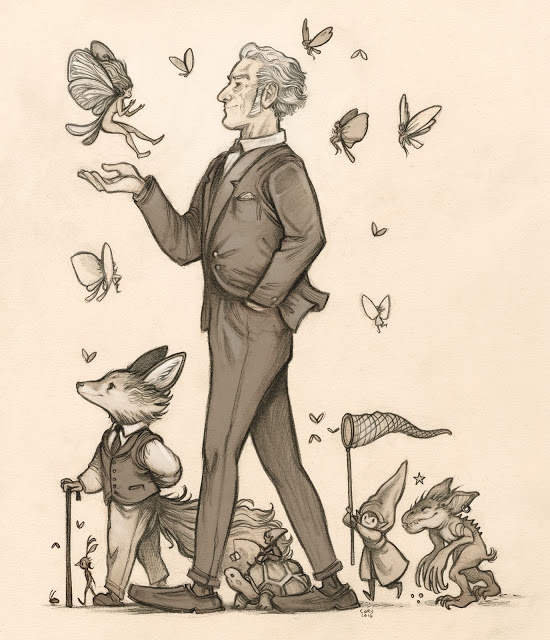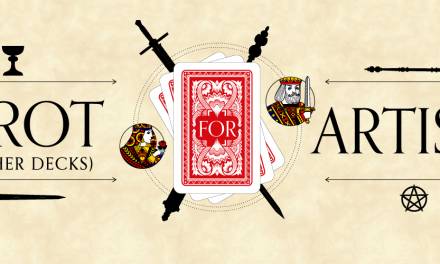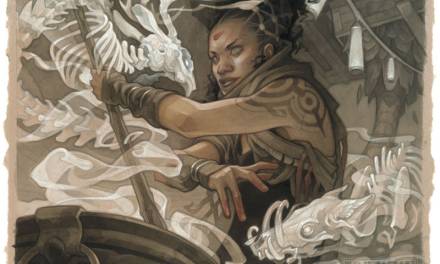I can not juggle. And yet I find myself juggling all the time. Fancy colored balls? Bowling pins? Chainsaws? No, no, juggling projects.
According to a recently published survey, 50% of illustrators polled said their project workload was higher in 2017 than in previous years.
Critical to a successful career in freelance illustration is an ability to juggle projects. Maintaining cash flow is paramount and in most cases what that looks like is juggling. Everyone’s needs are going to be different but ideally, for myself, I like to be finishing up one project, at the midpoint on a second, with a third ready to start soon. That way I’ve created some semblance of cash flow for myself. Three main projects going at once. Would I rather focus on one thing and put all my time into that? Sure, and I do from time to time, but those projects and budgets don’t come along everyday. More often than not, my week-to-week features some form of this goofy, acrobatic sleight of hand.
It’s when things begin to pile up that juggling projects starts to feel like playing multiple games of Tetris at once (with all the blocks falling at different rates). You clear some lines here but blocks are stacking up over there, you’re jumping back and forth. It can be panic-inducing. Emails are piling up, you’re running around putting out fires here and there, worst of all you feel the crushing weight of I will never get all of this done.
Well, let me start by saying this: just don’t get yourself in a situation like that! Oh wait! That’s profoundly unhelpful. Despite all your careful planning and superior time management skills something terrible has happened: You find yourself juggling one too many projects. Or chainsaws. (Because once it’s one too many projects it might as well be actual chainsaws.)
It happens. And going by that survey it sounds like it probably happened to a lot of people in 2017.
In any case, you’re overbooked. Now, it’s very good to understand how it happened and it’s very good to understand why it happened but I’m not concerned with either of those things right now. All that I am concerned with is grabbing you by the ears and dragging you out the bombed out foxhole you’ve gotten yourself into and back to illustrative safety. I’m going to show you what I do when I find that I’m juggling chainsaws.
At multiple times this past year I found myself working on a significant number of projects all at the same time. Wide variety, everything from publishing to animation. Some of it was self-inflicted (personal work, sketchbooks) but by and large it was all work for someone else. At the height it was between nine to twelve different, major things. Several times I found myself in a week with something for some stage of each of the projects due. I’m not going to lie, at times it was misery. Stability and cashflow in the life of a freelancer is never guaranteed so whether it’s I ought to take on this job because I don’t know if I’ll ever get another one or I ought to take on this job because I really want to be the one to bring it to life or some mix of the two, it’s very easy to find yourself in a position where you can not or do not want to say no. Please don’t misunderstand me here, I’ll never coach anyone into taking on everything that might come their way. That’s madness. Turn down bad clients and low paying work. But if a job sounds fun, the budget is acceptable, and I like the client, sure! Throw it on the pile, I’ll make it work.
 |
| Above. A Reasonable Amount of Work. |
So, you take on a reasonable amount of work and plan your life and calendar accordingly but! Here’s the thing! You’re still just one part of a multifaceted schedule. And all it takes is one person, be it an art director delaying feedback or something else took you longer than you thought it would, and like landing a Tetris piece in the wrong spot, you’ve got a major problem. Deadlines begin to bump up against one another and before you know it you’ve got a dozen chainsaws cartwheeling around your face. (Yes, I’m going to mix and match chainsaws and Tetris pieces for the rest of this article so please buckle yourself up.) Here’s where the guide come in to play.
The Practically Complete Guide On How To Do Almost Everything For Just About Everyone.
This guide is by no means exhaustive. And this guide is not for a normal schedule. This is guide is for getting multiple things done at once and keeping all your art directors happy. This is a BREAK GLASS IN CASE OF FIRE guide, this is a I’VE-GOT-TETRIS-SHAPED-CHAINSAWS-HAUNTING-MY-DREAMS-WELL-AT-LEAST-THE-DREAMS-I-WOULD-BE-HAVING-IF-I-COULD-SLEEP guide.
Get A Pencil.
Or pen, or crayon, I don’t care. You’re about to do a lot of writing. But writing’s not drawing and I need to get a lot of drawing done, you say. I just shake my head because we’re both crawling through mud under barbed wire in a hail of gunfire, because I’m still dragging you back from that bombed out foxhole. I’m going to get you home, kid. You’re a little delirious and we’re going to need to get you back to safety so you can take stock of your schedule.
Schedule.
I write everything down. My sketchbooks aren’t full of life studies or coffee shop patrons (I actually wish they were, I envy folks with sketchbooks like that) no, my sketchbooks are full of idea scribbles, bad drawings, and notes. My sketchbook is where I keep my schedule. Maybe you keep notes on your phone or in a Google doc. So long as you’re making a serious effort to organize your thoughts, that’s the key.
I write the date for reference and I write out each current project, bullet point. I jot down the deadlines for each and I organize accordingly. I write notes next to each job and go about planning what needs to happen and by when. Ideally, you’re getting a sense of which Tetris game (remember, you are playing multiple games of Tetris here) is stacking up the fastest and which one you got to start clear lines on right away.
You’re juggling chainsaws, you can’t afford to drop one. You’ve got to stay on top of your schedule and know what you have to get done. Otherwise it’s very easy to get overwhelmed and think, there’s just no way. There is a way! And it’s through careful planning. Maybe you got yourself into this mess, maybe someone else, did but by golly, I’m going to help get you out of it.
After you’ve gone through each job and made your notes you should have a good idea about what’s got to happen next. Sometimes at this stage I even make a calendar for the week. I like to figure out ideally what I’m going to accomplish by Friday. One, it’s crucial for you to know where you are in any given job, but two, it’s helpful to give your clients an update. No one likes to be in the dark, least of all art directors. Keep people up to date. It’s professional. Maybe there are circumstances where you can let an editor or art director know that you’re juggling chainsaws but I can’t think of any. It’s not their problem. It’s your job as an illustrator to solve problems and planning and note-taking will help. By organizing your thoughts on paper you are in a better position to identify which project requires your immediate attention (regardless of deadline).
Then you get to it for the day.
Before I’m done in the studio, I jot down everything that I need to get done tomorrow. This is a tiny form of decompression. I review what needs to happen for each project. This helps me keep on top of the overall timeline.
Decompression.
Start and end the day with decompression. This one is pretty simple. When you have this much on your plate you need to begin and conclude your day with a quiet moment. For me it’s usually the process of making coffee. I’ll never finish it and I’ll probably forget the cup somewhere but I’m going to make it. The act of grinding the coffee beans and getting water boiling helps me to focus myself. When the weather is nice (who am I kidding, even when it’s not) I’ll step outside for a moment of quiet before I get to it for the day.
When I’m done I’ll return to my notes, check off some boxes, and jot down what I need to do for tomorrow. You don’t always meet every goal for every day but by jotting things down you help to keep yourself informed. This goes a long way to help declutter your mind so you can rest. Because you’ve got to rest.
All-Nighter, More Like All-Never.
All-Never? I’ll Never? Look, I’m in my mid-30s with two small children so basically I feel 1000 years old. In my 20s I could all-nighter on accident but that’s not healthy (or all that possible for me anymore). Under extreme circumstances, and yes, this guide is for extreme circumstances, you can do it but goodness sakes, take care of yourself. Hopefully by planning you can keep yourself from having to resort to that.
In fact, the only all-nighters I did this past year were during two family trips (babies sleep a whole lot better if you drive at night so hey, let’s drive through the night)!
All of that to say, it’s no good if the work suffers. If things are getting that bad you might need help.
Call In Back Up.
This can turn juggling chainsaws into juggling fancy colored balls. If your schedule has gotten that bad, find yourself a team of trusted sub-contractors.
You’re still going to do the heavy-lifting, don’t misunderstand me. And it’s not possible or financially practical for every job but if there is some stage of a project, depending on the project, and you can send it to someone else while you make progress elsewhere, do it. Most often for digital work this looks like having someone else do color “flats” for me. I’ve got a handful of artists that I’ve gotten to know and trust over the years to call in when deadlines get tight.
This isn’t a silver bullet. You’re still planning and drawing and when you get the files back you’ll go about finishing the color work but to have someone step in and relieve some pressure while you focus on another project can make all the difference. I don’t know what that might look like for you. Maybe it’s finding someone to help package and ship prints, maybe it’s someone to help manage your website and social media.
One further illustration of this idea, my sister is a fantastic artist who works primarily in textbook illustration. We’ve been drawing together our whole lives so we speak each others visual language naturally. In the past I’ve had some textbook or educational projects where I would begin drawings (sketch and first pass at the pencil) and then sub-contract the finishing of those drawings to her. Think of a team a comic artists, penciller and inker. That would serve to free me up to clear some Tetris line elsewhere.
To be sure, I couldn’t or wouldn’t do this for every project. For the amount of work I do in a year it’s in the minority. I’m pretty single-minded and more than a little controlling when it comes to my work so calling in back up is for special circumstances only.
Exercise.
A simple point that’s just so easy to overlook. You’ve got to take care of yourself. You’ve got to get up and move around. If the deadlines (and chainsaws) don’t get you, sitting down all day will.
This is going to vary wildly person to person so I’ll keep it short. Just get yourself outside. It’s bad for your back, your joints, and your brains. Remember you’ve got to take care of the mind as well as the body and some form of exercise will help to do just that.
Find Your Outside.
For me it’s literally that, getting outside. Without a doubt, without question, I’ve got to get outside as often as I can in any given day.
I’m incredibly fortunate that my studio has a door right out to my garden. It’s an immediate boost for me to just step out there, walk around a bit, and get then back to it. I’ve got a short trail that winds it’s way through my woods and for an quick decompression I walk that and feel up to getting more juggling done, chainsaws or no. Why, couple that with an afternoon coffee and I just might answer some emails out there!
My point here is you’ve got to find your “outside” and maybe it’s the same as me, just step out for a minute. This might well be different for you, it could mean reading a book or playing a video game or really, I don’t know. But I’m sure you do.
Because when you’re juggling that much work you’ve got to takes steps to keep your head on straight or it could pull you down completely.
A Few Closing Thoughts.
These are sort of all related ideas and slightly different ways of expressing the same thought but if it’s helpful for anyone to hear, here you go.
Even if it’s only mostly true you have to establish an end date and goal. You’ve got to make it your job to hit deadlines. Everybody’s counting on it. But that’s not exactly what I’m talking about here, I’m talking about in the grand scheme of things do your best to know when you’re going to be done for yourself. It’s that light at the end of the tunnel thing. If you know, I can make it one more week, or I can do more month like this and be done, ok. Get the projects across the finish (in first place, too!) and then rest.
Think big picture and little picture. Focus on the ultimate goal and focus on what has to get done by the end of the day. It’s no good to sidetracked into the nitty-gritty details only to miss the larger picture.
Here’s hoping that 2018 is full great projects and not too many chainsaw juggling projects. But should you hear the tell-tale blaring of chainsaws or the stressful bleep-bloop of impending Tetris doom I hope that these thoughts will help you organize your schedule and see you through!












I always laugh at anger, because there’s nothing more futile and transitory….yet there are few emotions that we harbor most and perpetuate despite futility. Well, how else do you display mindfulness without analyzing emotion? If you can’t be clinical about it, then you have to be intuitive about it. Art portrays an emotional state, or an ideal state…..well, mindfulness is all about tangential thinking, hopefully correlative.
Tangential, hopefully correlative:https://www.youtube.com/watch?v=SkK2nSPQEVQ
Dude…..
Great article with super suggestions! Thanks for sharing 😀
Yes to all of this. I keep track of my schedule on Google calendar. I divide up the work on the calendar so I can see exactly what I have to accomplish each day. If I get ahead of schedule, or fall behind, or something else comes up, it’s easy to re-arrange things.
Lol @ juggling chainsaws. Every paragraph of this article resonated with me, we might be very similar in character! Do you also feel drawn to the Homo Universalis ideal?
I also have a silly question… I got here trying to visit James Gurney’s blog. Is this site the rebranding of his blog? I’m either lost or I’ve missed something big. Been living under a rock for a while…
Great article with super suggestions! Thanks for sharing 😀
대전출장마사지로 쉽고 간편하게 집에서 경험해볼 수 있습니다.